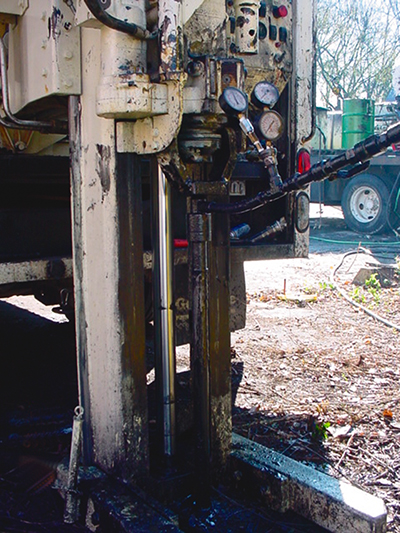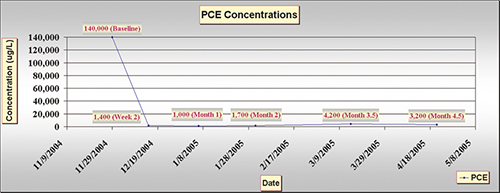
Valiant ‘Zero-Valent’ Effort Restores Contaminated Grounds
Originating Technology/NASA Contribution
Dense non-aqueous phase liquids (DNAPLs) are chemical compounds that can contaminate soil and groundwater to the point of irreparability. These substances are only slightly soluble in water, and are much denser than water. Because of their solubility, DNAPLs form separate liquid phases in groundwater, and because of their density, DNAPLs sink in aquifers instead of floating at the water table, making it extremely difficult to detect their presence. If left untreated in the ground, they can taint fresh water sources.
Common DNAPLs include chlorinated hydrocarbon compounds such as carbon tetrachloride, chloroform, tetrachloroethylene, and trichloroethylene. Trichloroethylene was used during the early days of the Space Program, as a solvent for flushing rocket engines, and for metal cleaning and degreasing of equipment, electronics, and heavy machinery. As a result, areas of Cape Canaveral’s Launch Complex 34—the site of several historic Saturn rocket launches occurring from 1959 to 1968—were polluted with chlorinated DNAPLs.
Through the direction and guidance of Dr. Jacqueline Quinn, an environmental engineer in the Spaceport Engineering and Technology Directorate at NASA’s Kennedy Space Center, a biodegradable environmental cleanup technology was developed to reductively dechlorinate DNAPL sources in polluted water at Launch Complex 34. It was important for Kennedy to nip this problem in the bud, in light of the fact that the Space Center is also a National Wildlife Refuge,to thousands of shorebirds, endangered sea turtles and eagles, manatees, alligators, and diverse habitats that include brackish marshes and salt water estuaries.
The success in remediating this historic launch site has led to numerous commercial applications that are restoring the health of our environmental surroundings.
Partnership
Quinn and three University of Central Florida professors developed the Emulsified Zero-Valent Iron (EZVI) technology, with collaborative support from the U.S. Department of Energy, the U.S. Department of Defense, the U.S. Environmental Protection Agency (EPA), GeoSyntec, Inc., and NASA’s Small Business Technology Transfer (STTR) Program at Kennedy. EZVI uses iron particles in an environmentally friendly oil and water base to neutralize toxic chemicals.
When speaking of the remediation work, Quinn noted, “What makes this new technology so attractive is that it is relatively affordable and easy to implement. Spinoff [companies] could help clean up polluted areas across the Nation and the world.”
To set such a cleanup effort into motion, Kennedy’s Technology Transfer Office issued non-exclusive licenses for EZVI to several companies, including Weston Solutions, Inc., and Toxicological and Environmental Associates, Inc.
Product Outcome
Headquartered in West Chester, Pennsylvania, Weston Solutions is a leading environmental and redevelopment firm, dedicated to developing and implementing solutions that safely and cost-effectively address complex remediation challenges. Interestingly, the company was the lead environmental contractor for the Space Shuttle
Columbia recovery effort, the largest emergency response ever conducted by the EPA. Following consummation of the Kennedy licensing agreement, Weston Solutions personnel were trained by NASA, with regard to the techniques for preparing EZVI and applying the patented emulsion technology in the field.
The company and one of its industrial clients recently evaluated the EZVI technology for application at one of that client’s sites in Tennessee that was impacted by high concentrations of chlorinated solvents that could not be remediated using conventional technology. Upon scrupulous assessment of site conditions and endorsement from associated regulatory agencies, EZVI was applied to treat a zone of soil located approximately 30 feet below ground surface.
The EZVI emulsion was injected under pressure into the target zone. Field work was conducted with strict attention to operating pressures, the amount applied, and the zone of injection. Further, an application array was established onsite to position the injection and assure even coverage over the contaminated “footprint.”
Immediately after treatment and at subsequent intervals thereafter, groundwater monitoring and soil-sample analysis were conducted to track the concentration trends and treatment effectiveness. Concentrations of the targeted contaminant dropped dramatically following the EZVI injection. Concurrently, concentrations of chloride increased, showing the dechlorination of the contaminant. According to Mike Corbin, technical director of Weston Solutions, “the regulators and the industrial client are very excited about the results so far.”
Weston Solutions is currently evaluating other sites—nationwide and in Canada—which contain DNAPLs or near-DNAPL concentrations. The company applied EZVI at a site in North Carolina over the past summer. Through the company’s applications of EZVI, additional knowledge is being gained on the performance of the technology in different types of soil and various other hydrogeologic environments. This experience will provide valuable feedback to the NASA inventors. The company has maintained open communication with the NASA team as commercial treatments progress.
Another licensee, Toxicological and Environmental Associates, also received NASA training and insight for creating a stable and reactive EZVI emulsion. The Baton Rouge, Louisiana-based company is facilitating the commercial application of the NASA technology through a spinoff company it formed, called Applied Science & Advanced Technologies, Inc. This will be done in place of traditional pump-and-treat methods, which can require decades of treatment time and operational costs, and steam injection and radio-frequency heating, which are very expensive and can trigger contaminant mobilization. According to the spinoff company, EZVI overcomes these limitations by providing a method that is quick, effective, and cost-competitive.
Applied Science & Advanced Technologies invested approximately 1 year in the commercialization of the manufacturing process to create the emulsion. It is currently capable of producing 2,500 gallons per day and can efficiently expand this ability as product demand increases. Additionally, the company has secured an exclusive agreement with an iron powder manufacturer. This will enable it to control costs associated with the production of the EZVI technology, which, in turn, should bolster its marketability in the remediation industry.
Throughout 2005, Applied Science & Advanced Technologies is scheduled to implement EZVI treatments at contaminated sites in Arkansas, California, Florida, North Carolina, and Texas. DNAPL contamination sites may include, but are not limited to, those created by dye and paint manufacturers, dry cleaners, chemical manufacturers, metal cleaning and degreasing facilities, leather-tanning facilities, pharmaceutical manufacturers, adhesive and aerosol manufacturers, and government facilities.
It should be noted that DNAPLs are present at 60 to 70 percent of all sites on the EPA’s Superfund National Priorities List, a registry of national priorities among the known or threatened releases of hazardous substances, pollutants, or contaminants throughout the United States and its territories.
The EZVI technology represents a major step forward in preserving the vitality of our planet and its inhabitants.

Weston Solutions, Inc.’s Emulsified Zero-Valent Iron remediation technology in process at a client site.

This graph depicts dense non-aqueous phase liquid concentrations before and after treatment was applied to a contaminated site by Weston Solutions, Inc. Concentrations of the contaminant dropped dramatically following injection of the treatment, and, though not depicted here, chloride levels increased, showing that the dechlorination was successful.

The Merritt Island National Wildlife Refuge, which shares a boundary with Kennedy Space Center, is home to diverse habitats and endangered animals, including the bald eagles pictured above. This eagle nest is 1 of 12 active nests on the premises. It is important for Kennedy to dechlorinate dense non-aqueous phase liquid sources in polluted water to protect these animals and area habitats.













